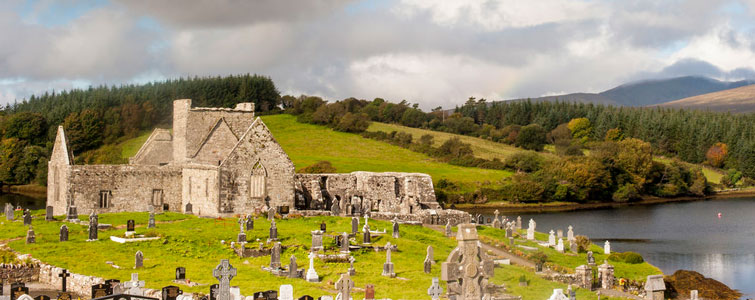Burrishoole Abbey, Newport in Co. Mayo

Burrishoole Abbey is a National Monument situated 2 miles N.W of Newport just off the main Achill road. The name Burrishoole is derived from the Norman word "Burgus" and "Umhaill" (later anglicized as Owel) the name given to the surrounding territory. The abbey is a hauntingly beautiful ruin situated at the edge of a quiet tidal estuary. The nave, chancel, tower and south transept remain, and there are ruins of domestic buildings and a cloister to the north.
Richard de Burgo, the Mac William Iochtair, founded the abbey of Burrishoole in 1469 as a friary for the Dominican Order of Friars, Preachers. Following his resignation as chieftain of the De Burgo clan, Richard retired to the Abbey and died there in 1473.
The Archbishop of Tuam, Donal O Muiri, had given permission for the founding of the abbey, but it was not until 1486 that the authorities in Rome officially recognized it in a Papal Bull issued in February 1486 to Archbishop William Joyce by Pope Innocent VII. The Pope then gave permission for the erection of a church with steeple and bell, and an abbey furnished with refectory, dormitory, cloisters and cemetery. It was built in Gothic style and though now merely a ruin it retains much of its former beauty.
Richard's grandson, Tomas Crosach (scarred) Bourke was responsible for the manufacture of the O Malley - Burgo chalice for the Burrishoole friars. Tomas was married to Grania O Malley and both their names, together with the date 1494 are inscribed on the base. This Grania was a great grand aunt of Granuaille, the sixteenth century Pirate Queen.
In August 1597, Sir Richard Malby, the Governor of Connaught, gave the following description of the Abbey: The 17th, I removed to Burrishoole, an abbey standing very pleasant upon a riverside, within three miles of the sea where a ship of 300 tons may lie at anchor at low water.
Malby placed a garrison within the abbey and captured Fr. Thady Duane. Fr. Duane later converted the soldiers and they settled among the local catholic people in the vicinity.
In 1652 the Abbey was attacked and plundered by Cromwellian soldiers. They brutally treated two nuns, Sr. Honoria Bourke and Sr. Honoria Magaen (Kane). Honoria Bourke was daughter of Richard an Iarainn, (Iron Dick), second husband of Granuaille and step- sister of Tiobaid na Loinge, who is buried at Ballintubber Abbey. The two nuns who were both over 100 years old fled to Oilean na Naoimh (Saint's island) in Lough Furnace. They were later captured, stripped naked (it was mid February) and had their ribs broken and were left to die.
During the seventeenth century several edicts were decreed ordering the friars to quit Burrishoole. Some were driven out while others remained on, living for the most part in mud cabins in close proximity to the abbey. The friars had opened a school at Burrishoole in 1642. The college operated under extreme difficulty until 1697, and because of the persecution they encountered they had at times to conduct their schooling at hidden locations within the woods. Among the professors to teach at Burrishoole were Fr. John O Ruane and Fr. Walter Jennings. The friars were expelled again in 1698 but returned in 1702. They watched the abbey go into ruin and in 1793 the roof eventually caved in and the friars left for the last time.
The Abbey at Burrishoole was always considered to be a hallowed burial place among the local clans. The oldest inscribed tomb within the Abbey is the O Kelly altar tomb with a Latin inscription dated 1623. Also reposing within the Abbey is Peregrine O Cleirigh, one of the Four Masters, who stated in his will, dated February 1664, (which still exists): I bequeath my soul to God and I charge my body to be buried in the monastery of Burgheis Umhaill. The remains of Fr. Manus Mc Sweeney are buried within the walls of the Abbey. Fr. Mc Sweeney, a local patriotic priest was hanged publicly by the British forces on the Market Crane, Newport in 1799 for the part he played in the French backed rebellion of 1798. He is fondly remembered in a ballad in the North Mayo Gaeltacht by the following words:
Ta a cholainn sa talamh is a anam i bhflaitheas. (His body is in the earth, but his soul is in paradise)
By Brian Hoban
